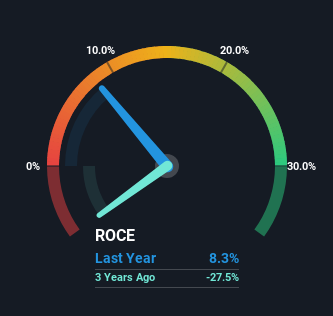- United States
- /
- Hospitality
- /
- NasdaqGS:PBPB
Potbelly's (NASDAQ:PBPB) Returns On Capital Are Heading Higher

What trends should we look for it we want to identify stocks that can multiply in value over the long term? Ideally, a business will show two trends; firstly a growing return on capital employed (ROCE) and secondly, an increasing amount of capital employed. This shows us that it's a compounding machine, able to continually reinvest its earnings back into the business and generate higher returns. So when we looked at Potbelly (NASDAQ:PBPB) and its trend of ROCE, we really liked what we saw.
Return On Capital Employed (ROCE): What Is It?
Just to clarify if you're unsure, ROCE is a metric for evaluating how much pre-tax income (in percentage terms) a company earns on the capital invested in its business. To calculate this metric for Potbelly, this is the formula:
Return on Capital Employed = Earnings Before Interest and Tax (EBIT) ÷ (Total Assets - Current Liabilities)
0.083 = US$13m ÷ (US$227m - US$67m) (Based on the trailing twelve months to March 2024).
So, Potbelly has an ROCE of 8.3%. In absolute terms, that's a low return but it's around the Hospitality industry average of 9.4%.
View our latest analysis for Potbelly

Above you can see how the current ROCE for Potbelly compares to its prior returns on capital, but there's only so much you can tell from the past. If you'd like, you can check out the forecasts from the analysts covering Potbelly for free.
What Can We Tell From Potbelly's ROCE Trend?
Potbelly has not disappointed in regards to ROCE growth. The figures show that over the last five years, returns on capital have grown by 934%. The company is now earning US$0.08 per dollar of capital employed. Speaking of capital employed, the company is actually utilizing 47% less than it was five years ago, which can be indicative of a business that's improving its efficiency. Potbelly may be selling some assets so it's worth investigating if the business has plans for future investments to increase returns further still.
On a side note, we noticed that the improvement in ROCE appears to be partly fueled by an increase in current liabilities. Essentially the business now has suppliers or short-term creditors funding about 30% of its operations, which isn't ideal. Keep an eye out for future increases because when the ratio of current liabilities to total assets gets particularly high, this can introduce some new risks for the business.
What We Can Learn From Potbelly's ROCE
In summary, it's great to see that Potbelly has been able to turn things around and earn higher returns on lower amounts of capital. And investors seem to expect more of this going forward, since the stock has rewarded shareholders with a 53% return over the last five years. So given the stock has proven it has promising trends, it's worth researching the company further to see if these trends are likely to persist.
Like most companies, Potbelly does come with some risks, and we've found 3 warning signs that you should be aware of.
While Potbelly isn't earning the highest return, check out this free list of companies that are earning high returns on equity with solid balance sheets.
New: Manage All Your Stock Portfolios in One Place
We've created the ultimate portfolio companion for stock investors, and it's free.
• Connect an unlimited number of Portfolios and see your total in one currency
• Be alerted to new Warning Signs or Risks via email or mobile
• Track the Fair Value of your stocks
Have feedback on this article? Concerned about the content? Get in touch with us directly. Alternatively, email editorial-team (at) simplywallst.com.
This article by Simply Wall St is general in nature. We provide commentary based on historical data and analyst forecasts only using an unbiased methodology and our articles are not intended to be financial advice. It does not constitute a recommendation to buy or sell any stock, and does not take account of your objectives, or your financial situation. We aim to bring you long-term focused analysis driven by fundamental data. Note that our analysis may not factor in the latest price-sensitive company announcements or qualitative material. Simply Wall St has no position in any stocks mentioned.
About NasdaqGS:PBPB
Potbelly
Owns, operates, and franchises Potbelly sandwich shops in the United States.
Solid track record with adequate balance sheet.
Similar Companies
Market Insights
Community Narratives



